Falafel! It’s one of my all-time favorite snacks. This homemade falafel recipe has hundreds and hundreds of positive reviews. Why? Because it’s just that delicious! Making authentic, traditional falafel is an interesting process, and it may be brand new to you. Never fear! I am here to walk you through each step, so you can achieve crispy, tender, tasty falafel every single time.
What is Falafel?
Falafel are crisp and delicious deep-fried legume fritters made with beans, spices, onions, and herbs. Legumes are well-soaked, then ground up and mixed with other ingredients. Next, the mixture is formed into small balls or patties, then fried in hot oil. The pre-soaked legumes are cooked during the frying process.
Most falafel today is made with chickpeas (aka garbanzo beans). However, in Egypt and other areas of the Middle East, fava beans are the legume of choice. It is often served alongside other popular regional Mediterranean recipes like hummus, as well as shawarma made from lamb or chicken.
The History of Falafel
This Middle Eastern food has a very long history. The word falafel may descend from the Arabic word falāfil, a plural of the word filfil, meaning “pepper.” Legume fritters, including versions made with fava beans and lentils, have existed in the Middle East for thousands of years.
According to The Encyclopedia of Jewish Food, written by my friend Gil Marks: “The first known appearance of legume fritters (aka falafel) in the Middle East appears to be in Egypt, where they were made from dried white fava beans (ful nabed) and called tamiya/ta-amia (from the Arabic for ‘nourishment’); these fritters were a light green color inside. Many attribute tamiya to the Copts of Egypt, who practiced one of the earliest forms of Christianity. They believed that the original state of humankind was vegetarian and, therefore, mandated numerous days of eating only vegan food, including tamiya.”
Likewise, the Torah, the Song of Songs, the Mishnah, and the Talmud all mention deep-fried lentil fritters, known as “ashishim.” This means early forms of falafel were enjoyed in this region since biblical times, at least. That’s some pretty ancient falafel!
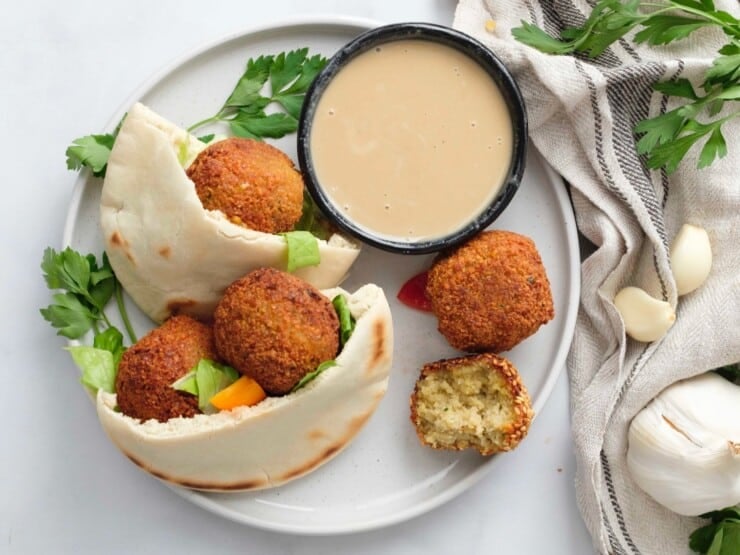
Ingredients and Notes
Please be sure to scroll down to the recipe card for the complete details!
- Chickpeas – I use chickpeas because they’re easy to find, and they’re tasty! Follow my tips to cook and soak dried chickpeas. Do not use canned chickpeas; they will not give you the proper result – you need to start with uncooked chickpeas. If all you have on hand are canned chickpeas, try this very delicious and falafel-like spicy panko chickpea patties recipe instead!
- Onion and Garlic – These ingredients add a pungent, sweet, savory taste. I like white onion, but yellow onion will also work. Then, I use roasted garlic cloves for extra depth.
- Herbs and Spices – Fresh parsley, salt, ground cumin, ground coriander, black pepper, cayenne pepper, and ground cardamom create the warm, savory flavor found in falafel recipes all over the world.
- Flour – Use all-purpose flour or chickpea flour to keep this recipe gluten-free. This absorbs any excess moisture and helps the falafel balls hold their shape.
- Leaveners – I use baking soda in the soaking water for the chickpeas to help soften them. You can also add baking powder in the falafel balls. This helps to create super tender, fluffy falafel.
- Oil – Use a neutral oil with a high smoke point for frying. I prefer avocado oil, but grapeseed oil, sunflower oil, canola oil, and peanut oil all work.
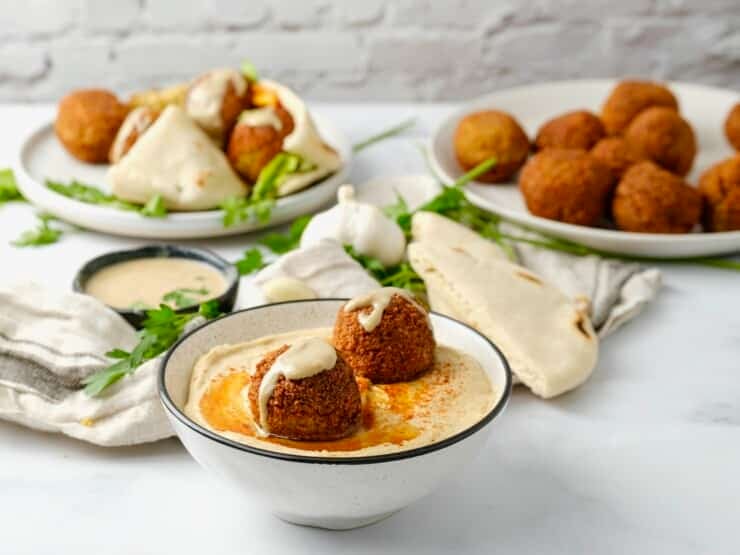
How to Make Authentic Fried Falafel Balls
Homemade falafel can be a little time-consuming. So, make sure to read through the entire recipe and plan ahead accordingly!
- Soak the chickpeas. Submerge the chickpeas in cold water, and add baking soda. Cover the bowl, and chill in the fridge for at least 12 hours or ideally up to 24 hours. This helps soften them, making them easy to blend.
- Combine and blend. Drain and rinse the chickpeas. Then, add them to a food processor along with the other ingredients. Pulse until a rough, coarse meal forms. Stop and scrape the sides of the bowl as needed to ensure all the ingredients are well incorporated. Be careful not to overprocess! The mixture should have a paste-like consistency, but shouldn’t be so smooth that it turns into hummus.
- Chill. Transfer the chickpea mixture to a bowl, and stir with a fork to remove any remaining chunks. Then, cover and refrigerate for 1-2 hours.
- Fry. Heat oil in a skillet over medium heat. In the meantime, portion the falafel mixture into equal-sized balls or slider-shaped patties. Then, fry on each side until golden brown, working in batches as needed. Drain them on a paper towel-lined plate, and enjoy!
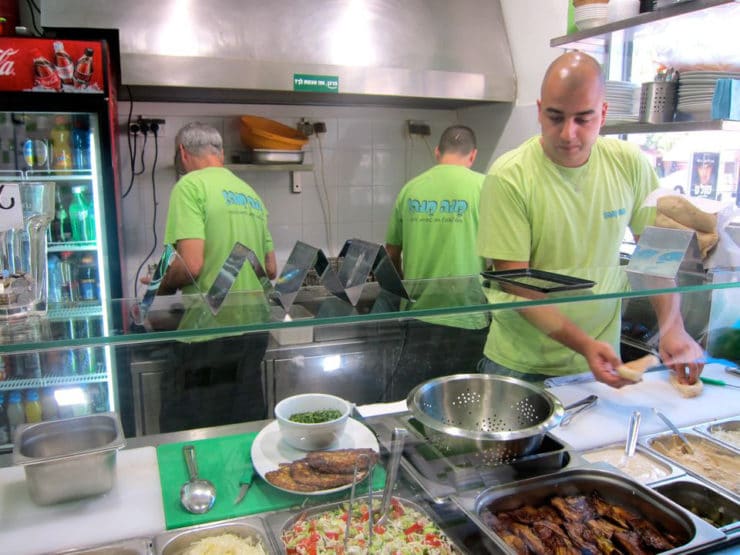
Tori’s Tips for the Best Crispy Falafel Recipe
- Divide the mixture. If you have a small food processor, divide the falafel ingredients in half before pulsing.
- Use a deep fry or candy thermometer. The ideal temperature to fry falafel is between 360 and 375 degrees Fahrenheit. The best way to monitor the temperature is to use a deep fry or candy thermometer to check the oil before frying.
- Portion evenly. I like to use a tablespoon or a falafel scoop to portion the falafel balls into equal-sized pieces and roll them between wet hands.
- Test a single falafel before frying the rest. I like to fry a test one in the center of the pan. If the oil is at the right temperature, it will take 2-3 minutes per side to brown (5-6 minutes total). If it browns faster than that, your oil is too hot, and your falafels will not be fully cooked in the center. Cool the oil down slightly and try again.
- Add flavor. I like to dip my falafel balls in sesame seeds before frying for a little extra crisp and nutty taste. However, I’ve also tested different flavor variations, adding chopped parsley or fresh cilantro or turmeric, and they all taste great. (See the recipe card below for details!)

Serving Ideas
My favorite way to serve homemade falafel is as a falafel sandwich. To do so, I use flatbread or slice warm pita bread in half to form two “pockets.” Then, I stuff them with the falafel balls and add-ons such as tahini sauce, Israeli salad, hummus, baba ganoush, or tabouli, and vegetables like shredded lettuce, tomatoes, red onions, and dill pickles.
Sometimes I also like to add sprouts, cucumber slices, roasted peppers, roasted eggplant slices, sunflower seeds, French fries, feta cheese, and yogurt or tzatziki for extra taste and texture.
Or, start with a large bowl and a base of lemony saffron couscous, cauliflower couscous, quinoa, or saffron rice, then add fresh veggies and all your favorite toppings.
Falafel balls are also great to serve as an appetizer or side dish with dips and main courses. Or, add them to a mezze platter for a party spread.
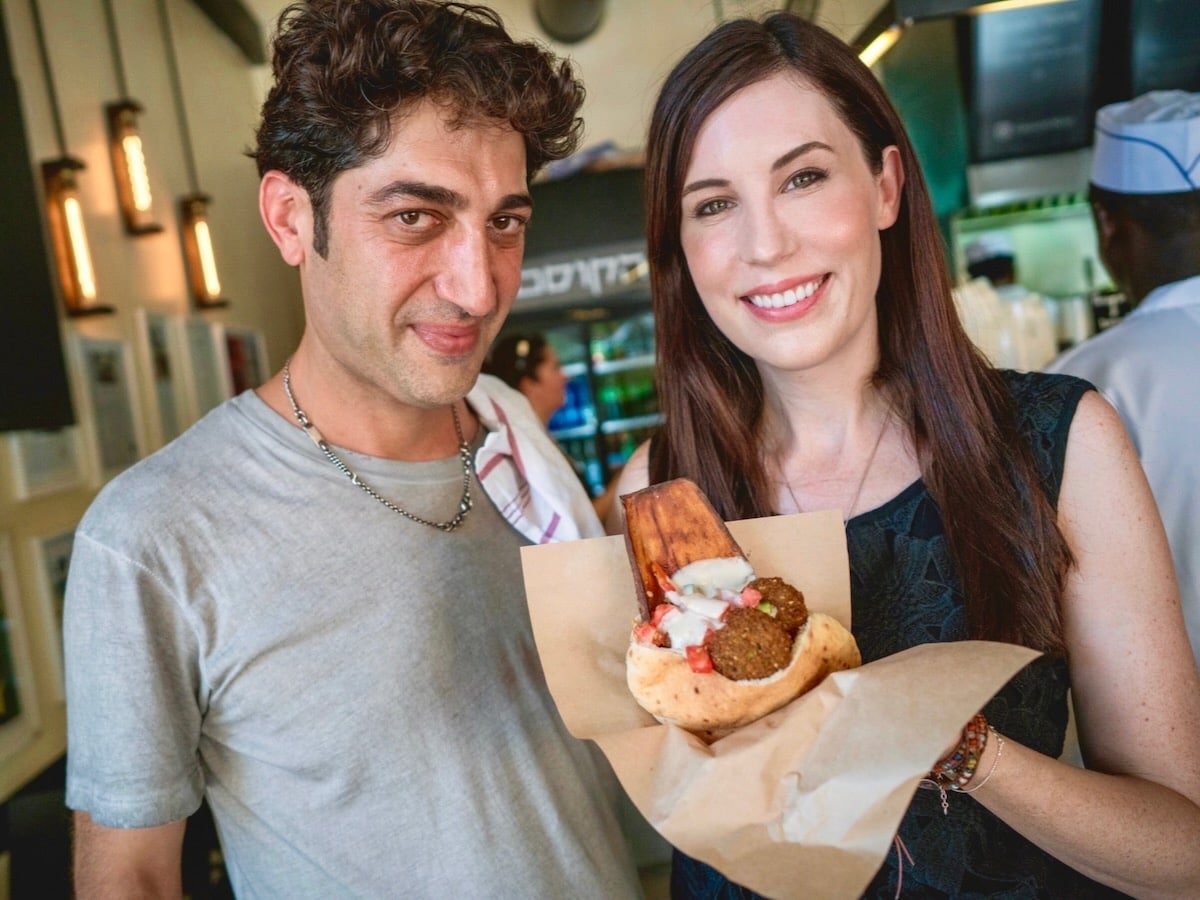
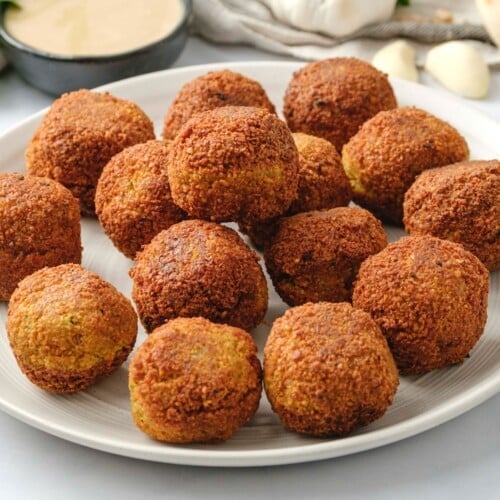
Falafel
Ingredients
- 1 pound dry chickpeas (also known as garbanzo beans) – you must start with dry, do NOT substitute canned, they will not work!
- 1/2 teaspoon baking soda
- 1 small onion, roughly chopped
- 1/4 cup chopped fresh parsley
- 3-5 cloves garlic (I prefer roasted garlic cloves)
- 1 1/2 tablespoon flour or chickpea flour
- 1 3/4 teaspoon salt
- 2 teaspoon cumin
- 1 teaspoon ground coriander
- 1/4 teaspoon black pepper
- 1/4 teaspoon cayenne pepper
- Pinch of ground cardamom
- 1 teaspoon baking powder (optional – makes the falafel more fluffy)
- Vegetable oil for frying – avocado oil, grapeseed oil, sunflower oil, canola oil, and peanut oil all work well (I prefer avocado oil)
NOTES
Instructions
- One day ahead: Pour the chickpeas into a large bowl and cover them by about 3 inches of cold water. Add 1/2 tsp of baking soda to the water and stir; this will help soften the chickpeas. Cover the bowl and let them soak overnight in a cool, dark place or chill in the refrigerator. The chickpeas should soak at least 12 hours and up to 24 hours, until tender (change soaking water for fresh water after 12 hours).

- They will double in size as they soak – you will have between 4 and 5 cups of beans after soaking.

- Drain and rinse the chickpeas well. Pour them into your food processor along with the chopped onion, garlic cloves, parsley, flour or chickpea flour (use chickpea flour to make gluten free), salt, cumin, ground coriander, black pepper, cayenne pepper, and cardamom. Note: if you have a smaller food processor, you will want to divide the ingredients in half and process the mixture one batch at a time.

- Pulse all ingredients together until a rough, coarse meal forms. Scrape the sides of the processor periodically and push the mixture down the sides. Process until the mixture is somewhere between the texture of couscous and a paste. You want the mixture to hold together, and a more paste-like consistency will help with that… but don't over-process, you don't want it turning into hummus!

- Once the mixture reaches the desired consistency, pour it out into a bowl and use a fork to stir; this will make the texture more even throughout. Remove any large chickpea chunks that the processor missed.Cover the bowl with plastic wrap and refrigerate for 1-2 hours.Fill a skillet with oil to a depth of 1 ½ inches. Use cooking oil with a high smoke point (oil suggestions can be found in the ingredient list). Heat the oil slowly over medium heat. The ideal temperature to fry falafel is between 360 and 375 degrees F; the best way to monitor the temperature is to use a deep fry or candy thermometer. After making these a few times, you will start to get a feel for when the oil temperature is "right."Meanwhile, form falafel mixture into round balls or slider-shaped patties using wet hands or a falafel scoop. I usually use about 2 tbsp of mixture per falafel. You can make them smaller or larger depending on your personal preference. The balls will stick together loosely at first, but will bind nicely once they begin to fry.

- If the balls won't hold together, place the mixture back in the processor again and continue processing to make it more paste-like. Keep in mind that the balls will be delicate at first; if you can get them into the hot oil, they should bind together and stick. If they still won't hold together, you can try adding 2-3 tbsp of flour or chickpea flour to the mixture. If they still won't hold, add 1-2 eggs to the mix. This should fix any issues you are having.Before frying my first batch of falafel, I like to fry a test one in the center of the pan. If the oil is at the right temperature, it will take 2-3 minutes per side to brown (5-6 minutes total). If it browns faster than that, your oil is too hot and your falafels will not be fully cooked in the center. Cool the oil down slightly and try again.

- When the oil is at the right temperature, fry the falafels in batches of 5-6 at a time until golden brown on both sides. Once the falafels are fried, remove them from the oil using a slotted spoon. Let them drain on paper towels.

- Serve the falafels fresh and hot; they go best with a plate of hummus and topped with creamy tahini sauce. You can also stuff them into a pita.

- SESAME FALAFEL VARIATION: After forming the balls or patties, dip them in sesame seeds prior to frying. This will make the falafel coating crunchier and give it a slightly nutty flavor.

- HERB FALAFEL VARIATION (GREEN FALAFEL): Add ½ cup additional chopped green parsley, or cilantro, or a mixture of the two prior to blending.

- TURMERIC FALAFEL (YELLOW FALAFEL): Add ¾ tsp turmeric to the food processor prior to blending.

- HOW TO MAKE A FALAFEL PITA: Making a falafel pita is actually really simple. The two main ingredients are pita bread and falafel. Cut the pita bread in half to form two “pockets.” Each pocket is a serving size. Stuff the pocket with falafel, as well as any add-ons you fancy.Here are some traditional add-ons that can be added to your pita: tahini sauce, shredded lettuce, diced or sliced tomatoes, Israeli salad, onions, dill pickles, hummus, tabouli.Here are some less traditional add-ons that are also tasty: sprouts, cucumber slices, roasted peppers, roasted eggplant slices, sunflower seeds, french fries, feta cheese, yogurt, tzatziki.

Nutrition

tried this recipe?
Let us know in the comments!
If you enjoyed this recipe, I’d love it if you left me a star rating and comment below. Also, don’t forget to share and tag us on Facebook and Instagram!
FAQs
This recipe is best served right away. However, you can store cooked leftovers in an airtight container in the fridge for 2-3 days.
I’ve never tried freezing this recipe, but some readers have had good luck with freezing both the uncooked chickpea mixture and the cooked falafels.
Personally, I don’t like baking this recipe, finding that it tends to dry out. However, if you want to give it a try, prepare and shape the falafel dough into patties as usual.
Then, arrange them on a greased or parchment-lined baking sheet, and brush the top of each falafel patty with extra virgin olive oil. Bake in the oven at 400 degrees Fahrenheit for 20-25 minutes, turning halfway through, until golden. If you read through the comments, you’ll see tips from some readers who have tried this method with some success.
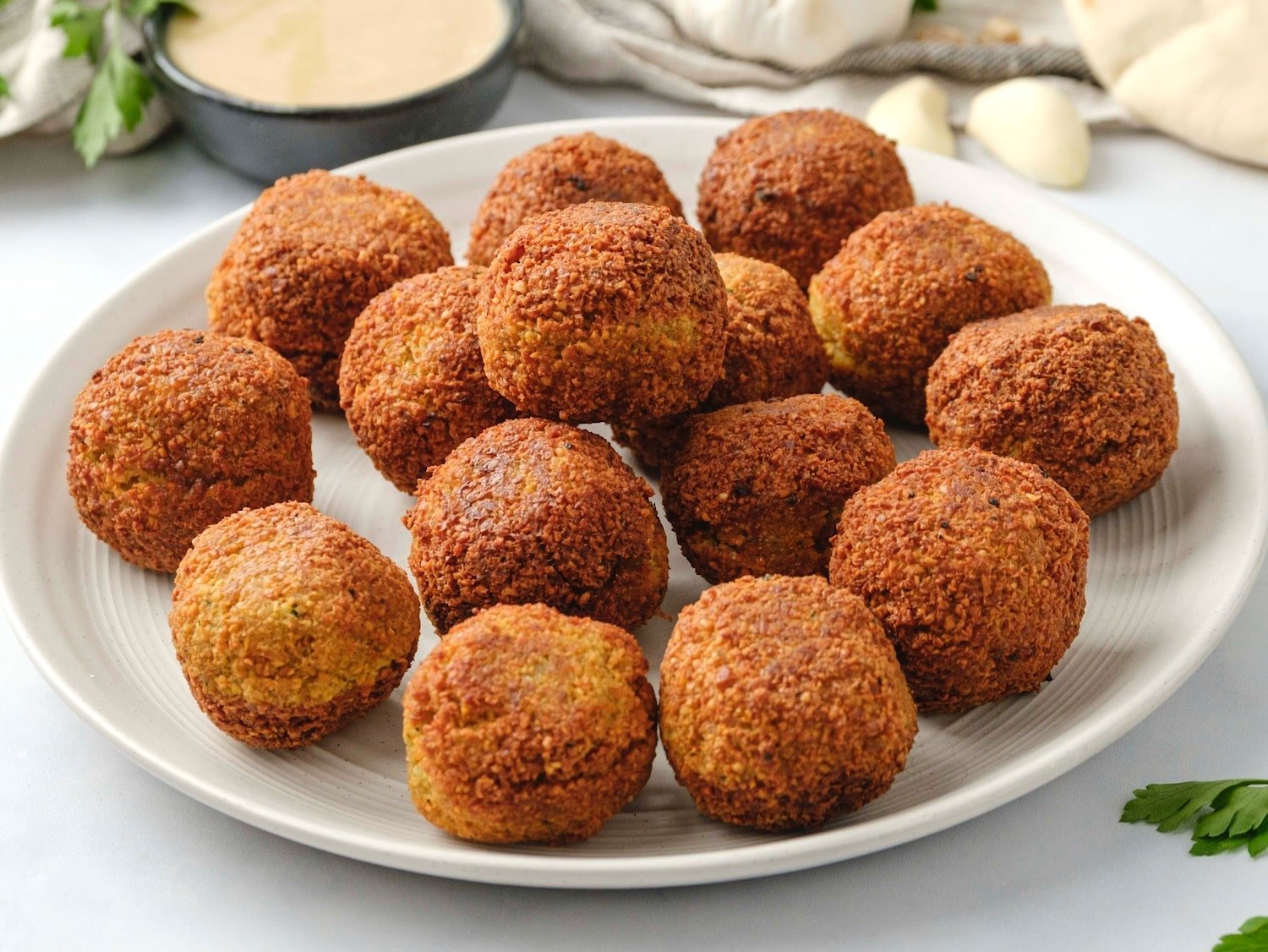

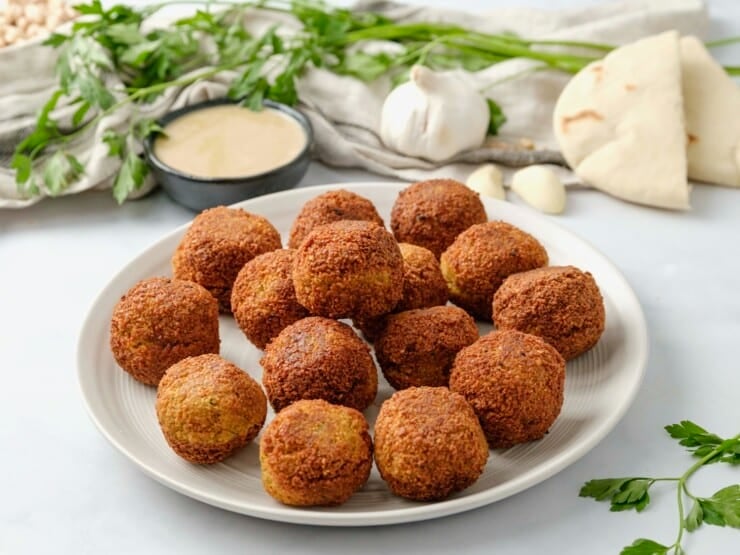







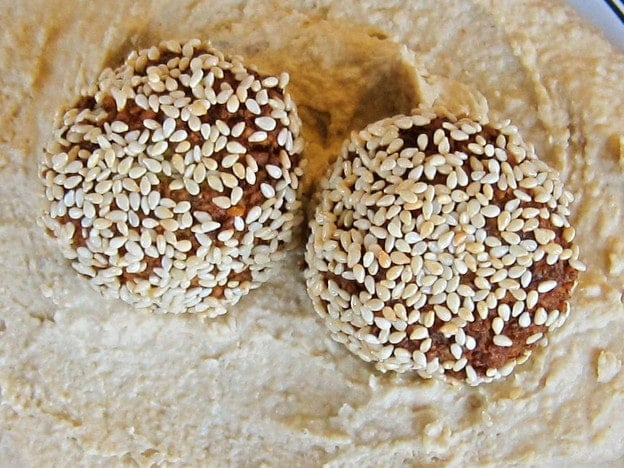
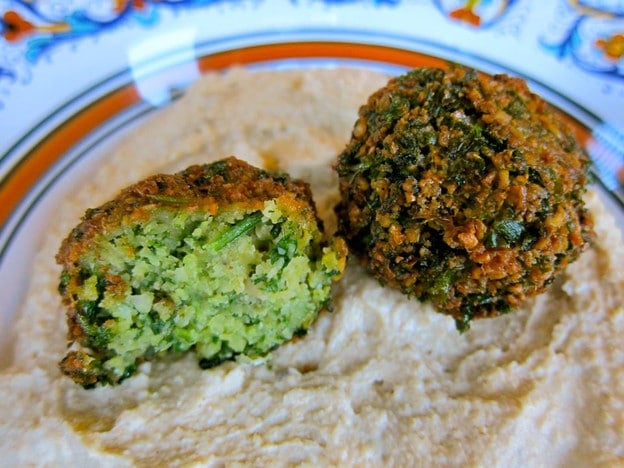
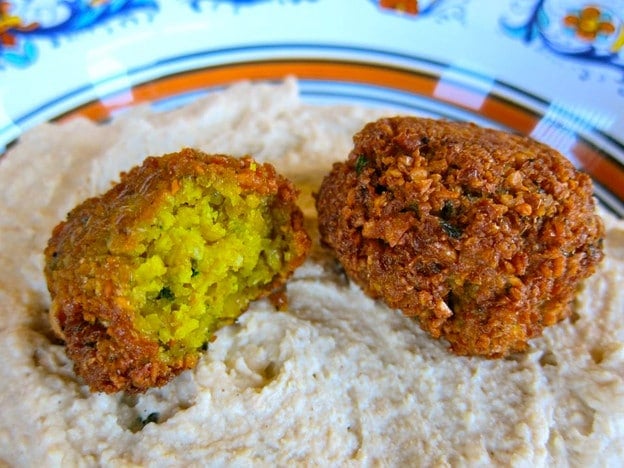



I have made this recipe so many times because it truly is the best falafel I’ve ever had! Thank you so much for this recipe!
Can navy beans be used?
R can potatoes be used instead of chickpea?
This is by far the best falafel recipe. I found it years ago and have made these probably 100 times! Plus shared to others. I’ve got the consistency down to a fine art now…it can be a bit tricky at first but once you know when to stop processing, the balls will turn out perfectly. Refrigeration before forming into balls or patties is key – don’t skip this step! I regularly ‘tweak’ the ingredients to my liking. This recipe is super-forgiving. We are chilli-mad so I always add fresh chillies! And I tend to add more cumin and a dash of curry powder as well. I also often add extra greens…both parsley and fresh cilantro. I only ever shallow-fry and drain well. No issues with this at all – just use a healthy oil with a high smoke point. Thank you Tori.
I have discovered that I am allergic to chickpeas so I can’t ever get falafel at restaurants ever though I love it. I was happy to come across your Egyptian variation using fava beans. I’ve made it a few time now. The first two times I used dried fava beans and the modifications listed. Tonight I used fresh fava beans and the regular ingredients. It’s a banger every time. Thanks!
Excellent recipe, have been using it for quite a few years, never fails. Just THE bestest.
I am going to make it tomorrow again, need to prepare my chickpeas )
Thank you sooo much Tory ☺️😋
You’re welcome Olga!
I’ve been making these for a while, and this is a great recipe that works for a variety of cooking methods. I form the raw balls, then freeze them on parchment paper and put them in a ziploc once they’re frozen for long-term storage. Both frying and baking work, but for my favorite convenience meal I just place the frozen (uncooked) falafel on a parchment paper lined baking sheet (usually with some veggies to roast), drizzle olive oil over the top, and bake in the toaster oven at 375-400 until they’re nicely browned. If I’m paying attention, I usually flip the falafel once the underside browns, and that makes them evenly browned on both sides. I love this recipe so much, and the flexibility to freeze and bake makes it a lot easier to make healthy decisions on the days I really don’t want to bother cooking.
I’ve been making falafel for yearsss and follow this recipe. It is the best falafel coming from someone who lives in the middle east
I have made this recipe many times over the years and my friends and guests always love it. Naturally vegan and gluten free (if using chickpea flour) and allergy friendly–so it’s the perfect dish to serve for others especially if you’re not sure of everyone’s needs and preferences. I had a crisis the other day where I forgot to soak the chickpeas–essential for traditional falafel!!! I scoured the internet for solutions and did an 8 hour soak starting with boiling water from my kettle. After the initial boiling water cooled, I drained it and replaced it with cool water for the remainder of 8 hours. By 3:30pm, the chickpeas had doubled in size. I continued the recipe as followed and had dinner on the table for our guests by 5:30. The falafel came out perfectly.
All that to say if you forgot to soak overnight, you can attempt to do a full-day soak if you remember early enough in the morning (I started at 7:30am) and hope for the best.
I served the falafel with a vegan tzatziki made with Kite Hill Greek yogurt, shatta, pickled red onions, Israeli salad, shredded lettuce, basmati rice, pita bread.
I use this recipe with home-grown fava beans. I soak them, but never peel them, becasue peeling them is waaaay too time consuming. I then usually double all the remaining ingredients, from the baking soda to the baking powder, because we like lots of flavour around here. The result is always the best-ever falafel balls – far better than anything I can buy at a restaurant locally. Thanks Tori!
So glad you’re enjoying it Mark!
Hey, thank you for post and authenticity!
I remember a long time ago, I had some falafel in pita bread made fresh by a few Israeli students, she added a lot of stuff in the pocket- like pickles and Chutneys. Some spicy, some tangy, I don’t remember much but the experience and taste was divine! I always crave it. I’d really appreciate if you could share the traditional accompaniments to the dish.
Gratefully,
Swetha
Very tasty, thank you for sharing your recipes. I was looking for Egyptian style falafels made from fava beans and found your site. I used split fava beans so that I didn’t have to skin them after soaking, and soaked them for a day and a half. I roasted the garlic as you suggested, which gave them a nice more subtle flavour. I wasn’t sure how the dill would be, as I’ve not put dill in falafels before, but everything blended together really well and they were delicious. I will definitely be making this recipe again!
What a fantastic recipe, the flavor has to be experienced to be fully appreciated. It wasn’t until my small town health food store stopped carrying Falafel, dry in a box that I broke down and began looking for a good recipe.These days I cook for one person, so the effort of deep frying isn’t worth the trouble. I solve this problem and the issue of storage by making falafel burgers. Taking the freshly made falafel I use an approx. 3 in. diameter x 1/2 in. deep cookie cutter and fill it to make uniform patties. Prepare for freezing by laying them on a foil covered cookie sheet before popping them in the freezer. Then once frozen stack, bag them and have them on hand for quick use. To fry I put a pattie in a small non stick skillet then drizzle just enough olive oil on it that the surface is covered. Then turn the burger and do the same for the other side. Begin by frying one side on very low heat until it can be lifted with a spatula and is slightly browned. Flip it and cook this side to final crispyness desire refill and finish off the first side. I like my burgers on toasted white bread with your tasty hummus spread on one slice and melted cheese on the other. This recipe made about 16 burgers with the size cutter I used. The amount of oil used and soaking the pattie seems noticeably less. I’ll probably begin using some dressings on them at some point, for now a tasty soups are great for dipping bites in. Thanks I think a lot of your web site.
Great tips Scott, thank you for sharing!
Hi, sorry if this is a dumb question, but I thought you had to (not just soak but also) cook the chickpeas first before using them in any falafel recipe? I am not used to using soaked but uncooked beans in recipes. Can I just double check this with you?
In other words, just frying the uncooked beans at the end of recipe for a few minutes in oil (to make the falafels) which really just crisps the outside but leaves the inside tender and largely incompletely cooked doesn’t seem like enough cooking for the chickpeas. Aren’t the chickpeas remaining uncooked essentially, especially on the inside of the falafel?
Isn’t it bad to consume beans not completely cooked?
Actually, traditional falafel is made with soaked beans, not cooked beans. The frying process cooks the beans and makes them tender – the inside of the falafel should be quite cooked when complete. If you prefer using pre-cooked beans, try this recipe instead: https://toriavey.com/spicy-panko-chickpea-patties-recipe/
Hi there, how long will the mixture keep in the fridge?
A great recipe, easy to follow and the falafel are absolutely delicious!
Loved it! Instructions were really to follow, they came out pretty well on the first try!
*note I did not add optional baking soda to the mix
Some of my personal suggestions:
– I found it to be a tad bit dry – may be an error on my part. I’m might invest in getting a scoop to pack them dense so that they retain more moisture when fried. Would make the prep much faster too. Could also add extra parsley or whatever vegetable for the moisture
– Flavours not strong enough for me. Could use a bit more (1/4 tsp?) of all the spices.
Also try processing the mixture just a bit more, so that it is more densely packed – this should help with the moisture issue.
Did you mean to put baking soda and baking powder in the recipe for falafel?
Please see the notes section above for answer to this question.
Please would you be so kind and tell me what you call the red hot sauce that you squeeze in pocket.Thanks
I love to learn more recepies. Thank you
Saludes desde honduras
Fantastic recipe!! Tried your egyptian version too – first time I’ve enjoyed eating broad beans 🤓 my whole (extended) family loved both types of falafel, only one is a vegetarian 👍 many thanks for your detailed notes and guidance; the sprinkling of advice throughout was priceless – this is going in my tried n tested recipe collection under ‘bomb proof’👩🏻🍳 xxx